Are you a Quiet Speculation member?
If not, now is a perfect time to join up! Our powerful tools, breaking-news analysis, and exclusive Discord channel will make sure you stay up to date and ahead of the curve.
I've always been a fan of Gerry Thompson's Daily Digest column on StarCityGames, especially when he highlights a Modern deck. Because most Modern players don't sit at their computer spamming F5 to refresh the MTGO Daily at noon every day, Gerry's articles are a great way to get the scoop on cool new Modern decks. Unfortunately, probably due to editorial guidelines, the Digests are often quite short and don't go into the level of detail many Modern players might be looking for. Enter our new "Deck of the Week" column. This series will spotlight an interesting and innovative Modern list from recent tournaments, and you can expect a new one every week.

"Deck of the Week" will feature a combination of successful rogue strategies, brave new brews, and unique technology in old Modern staples. Some decks will be more competitive than others, but in the spirit of our Undying Pongify deck spotlight from last week, I'll always relate the specific list back to broader deckbuilding principles and the overall Modern metagame. Even if you aren't interested in the deck itself, hopefully you'll find something useful in the analytic methods and deck evaluation approach: these are universals that can help you with any deck. Let's kick off the new column with a tribal archetype we've all heard about, especially if you started playing around Innistrad block: Humans.
[wp_ad_camp_1]
The List and Strategy
If you browse MTGO results as much as I do, you've seen some version of the 5C Humans list before. These creature-heavy lists combine an aggressive gameplan with some "hatebear" style creatures to pressure an opponent's win conditions. In a recent daily, iLoveShimakaze piloted his 5C Humans deck to a 3-1 finish:
5C Humans, by iLoveShimakaze (MTGO Daily 7/19/2015, 3-1)
Before we even get to the "Improvements" section, it's clear this deck needs a lot of tuning: Knight of New Alara has no business winning anything in Modern. Despite several deficiencies, the deck features some core synergies and card choices which are worth our attention. These strengths are shared by many of the other Humans lists we have seen in MTGO Dailies, suggesting common themes that have made Humans successful in the past.
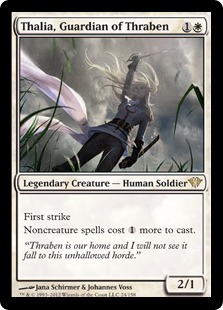 Thalia, Guardian of Thraben is a driving force behind Legacy's Maverick and Death and Taxes decks. Unfortunately for D&T fans, Thalia hasn't made as big an impact in Modern, despite her presence in our own D&T lists along with Hatebears. Humans is probably not the deck to push her to top-tier play, but the deck does showcase her power. Looking at the current tier 1 decks in Modern, we see a lot that are going to struggle against an active Thalia. Burn, Grixis/UR Twin, Grixis Control, and RG Tron do not want to face down a turn two Thalia, especially if they are on the draw. Although many of these decks can answer her in some way, it will often set them back a turn, both because they had to commit resources to killing Thalia and because they spent an additional mana to do so. Humans is aggressive enough to capitalize on that lost turn, which makes the deck a perfect home for Thalia.
Thalia, Guardian of Thraben is a driving force behind Legacy's Maverick and Death and Taxes decks. Unfortunately for D&T fans, Thalia hasn't made as big an impact in Modern, despite her presence in our own D&T lists along with Hatebears. Humans is probably not the deck to push her to top-tier play, but the deck does showcase her power. Looking at the current tier 1 decks in Modern, we see a lot that are going to struggle against an active Thalia. Burn, Grixis/UR Twin, Grixis Control, and RG Tron do not want to face down a turn two Thalia, especially if they are on the draw. Although many of these decks can answer her in some way, it will often set them back a turn, both because they had to commit resources to killing Thalia and because they spent an additional mana to do so. Humans is aggressive enough to capitalize on that lost turn, which makes the deck a perfect home for Thalia.
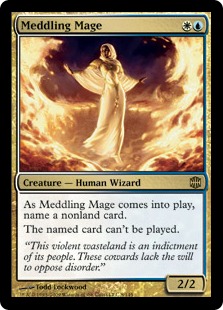 Meddling Mage is one of those Modern cards everyone wants to work, but no one can seem to use effectively. It's in the same category as Shadowmage Infiltrator and Solemn Simulacrum: cards that used to be good in old Standard and Extended seasons that can't cut it in Modern. Incidentally, all of them are Invitational cards (Dark Confidant gets a pass here). Thankfully for Chris Pikula fans everywhere, Humans gives renewed hope to Mage fans in Modern. Two of Modern's defining characteristics are 1) its diversity and 2) the importance of having specific answers to narrow threats. Mage directly addresses both these issues, giving Humans players a maindecked, proactive solution to some of Modern's most problematic cards. Most Modern players are able to identify decks within the first 1-2 turns, which makes Mage a great way to screw up an opponent's plans. Of course, another defining Modern characteristic is the prevalence of cheap removal (i.e. the Bolt test), which remains a problem for Mage. Thanks to an aggressive gameplan coupled together with other interactive tools, like Thalia, Mage is able to overcome some of these challenges and remain relevant in the Humans shell.
Meddling Mage is one of those Modern cards everyone wants to work, but no one can seem to use effectively. It's in the same category as Shadowmage Infiltrator and Solemn Simulacrum: cards that used to be good in old Standard and Extended seasons that can't cut it in Modern. Incidentally, all of them are Invitational cards (Dark Confidant gets a pass here). Thankfully for Chris Pikula fans everywhere, Humans gives renewed hope to Mage fans in Modern. Two of Modern's defining characteristics are 1) its diversity and 2) the importance of having specific answers to narrow threats. Mage directly addresses both these issues, giving Humans players a maindecked, proactive solution to some of Modern's most problematic cards. Most Modern players are able to identify decks within the first 1-2 turns, which makes Mage a great way to screw up an opponent's plans. Of course, another defining Modern characteristic is the prevalence of cheap removal (i.e. the Bolt test), which remains a problem for Mage. Thanks to an aggressive gameplan coupled together with other interactive tools, like Thalia, Mage is able to overcome some of these challenges and remain relevant in the Humans shell.
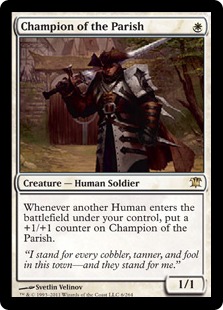 Tribal synergies usually aren't good enough in Modern (with the historic exception of Merfolk and the recent results from Elves). In many cases, you are better off throwing Nacatls and Goyfs at an opponent than trying to build off synergies between your creatures. Even better still is throwing Ravagers/Inkmoths or Bolts/Spikes at the opponent. Humans challenges this paradigm with a variety of micro-synergies between its different cards. The key term here is micro-synergies: interactions that are incidental to the cards you are already playing. For instance, because you're already playing Mage and Thalia, you might as well add both Experiment One and Champion of the Parish as your aggressive one-drops. Now that you are so deep into Humans, Cavern of Souls and Falkenrath Aristocrat fit in nicely. These kinds of micro-synergies give Humans some added firepower in fairer matchups (Abzan, Jund, Grixis Control, etc.), where your average board state is much stronger than in a Zoo or Burn deck. Affinity is the king of micro-synergies, but Humans is another great example of it in action.
Tribal synergies usually aren't good enough in Modern (with the historic exception of Merfolk and the recent results from Elves). In many cases, you are better off throwing Nacatls and Goyfs at an opponent than trying to build off synergies between your creatures. Even better still is throwing Ravagers/Inkmoths or Bolts/Spikes at the opponent. Humans challenges this paradigm with a variety of micro-synergies between its different cards. The key term here is micro-synergies: interactions that are incidental to the cards you are already playing. For instance, because you're already playing Mage and Thalia, you might as well add both Experiment One and Champion of the Parish as your aggressive one-drops. Now that you are so deep into Humans, Cavern of Souls and Falkenrath Aristocrat fit in nicely. These kinds of micro-synergies give Humans some added firepower in fairer matchups (Abzan, Jund, Grixis Control, etc.), where your average board state is much stronger than in a Zoo or Burn deck. Affinity is the king of micro-synergies, but Humans is another great example of it in action.
Of course, 5C Humans isn't without some big weaknesses. For one, this particular list lacks any removal or spell-based interaction. This can be very risky in a format full of remove-or-die threats like Exarch, Primeval Titan, Blighted Agent, and Inkmoth Nexus. The manabase is also obscenely vulnerable to Blood Moon, although it's surprisingly painless compared to other 3+ color decks. With so many decks running Moon in the board, Ancient Ziggurat and Pillar of the Paruns aren't exactly what you want to be dropping on turns one and two. Finally, the deck is a little "too fair" for Modern. Curving turn one Champion into Thalia, followed by Anafenza, then Huntmaster feels too cute when compared to other decks' plays on turns one through four. Humans has enough going for it that I think we can work through these shortcomings, but we'll need to focus on addressing them.
5C Humans in Context
It's always risky to look for successful decks on MTGO because of the nature of events. With so many tournaments every day, especially with many finishes decided on byes, no-shows, intentional draws, and other extra-game methods, we can't always tell if a deck is finishing because it's good or lucky. Also, as the old adage goes: "If you throw enough darts at a board you'll get a bulls-eye eventually". MTGO has a lot of random decks appearing in the Daily listings; just because they go 3-1 doesn't make them a real consideration for a PPTQ. This worry is very much present in 5C Humans. One way to address this is to look at the historical and metagame context for the deck, checking our theories around Humans against the hard data. This is a great tool for confirming any deck's viability, so whether you love or hate Humans, this approach can be valuable in your own testing, brewing, and deck development.
 Humans may not be Grixis Delver or even Stompy or Smallpox Loam, but the deck has seen a number of MTGO finishes since March 2015. With six appearances in that time, Humans' MTGO share is comparable to Esper Gifts (5), Goblins (8), 8Rack (8), and GW Hatebears (9). Three of those finishes were accomplished by one player, FeedMe, who took a red-heavy Humans list to 3-1 showings on 3/25, 5/3, and 5/20. We also saw a lot of 5C Humans action during the end of the 2014 Modern season. MTGO player Meltiin took his own list, one very similar to the deck featured in this article, to a 4-0 finish in an 11/14 Daily, on top of three other finishes in the following months. Meltiin added in the non-human Siege Rhino to his four lists, an addition later Humans players dropped on MTGO. The similarities between these lists do not necessarily mean the deck is the next big thing, but they are encouraging datapoints for those looking to replicate Humans' success.
Humans may not be Grixis Delver or even Stompy or Smallpox Loam, but the deck has seen a number of MTGO finishes since March 2015. With six appearances in that time, Humans' MTGO share is comparable to Esper Gifts (5), Goblins (8), 8Rack (8), and GW Hatebears (9). Three of those finishes were accomplished by one player, FeedMe, who took a red-heavy Humans list to 3-1 showings on 3/25, 5/3, and 5/20. We also saw a lot of 5C Humans action during the end of the 2014 Modern season. MTGO player Meltiin took his own list, one very similar to the deck featured in this article, to a 4-0 finish in an 11/14 Daily, on top of three other finishes in the following months. Meltiin added in the non-human Siege Rhino to his four lists, an addition later Humans players dropped on MTGO. The similarities between these lists do not necessarily mean the deck is the next big thing, but they are encouraging datapoints for those looking to replicate Humans' success.
Perhaps more important than Humans' prevalence is the overall metagame in which the deck lives. Humans doesn't need to reach 5%+ of the metagame to be successful; it simply needs to match up favorably against the decks you are likely to encounter. In Humans, this means leveraging the three strengths I mentioned above and converting them to wins: Thalia, Mage, and your aggressive tribal synergies. Looking over the current tier 1 decks, we see a number of decks that are weak to this Humans core. This includes Grixis Control, RG Tron, and Jund. Thalia alone is a beating against these decks, and she gets even nastier when paired with pressure from Champion, Experiment, and Aristocrat. Mage is also a strong bullet in all of those matchups, eliminating an opponent's access to key cards like Cryptic Command or Pyroclasm. Other tier 1 decks are better against Humans, including both Grixis and UR Twin. Although these decks are likely to lose the midrange game, Humans is very weak to their combo plan. A similar problem is at play with Burn and Affinity. Thalia puts in work against the former and Huntmaster stabilizes against the latter, but both matchups return to the core problem with Humans: the deck is a bit too fair. Even so, with a little more interaction and improved card choices, it seems possible to get Humans to the point where it has decent matchups against at least five of the top seven decks in the format. That's a great place for a brewer to start, and it's how we'll kick off our next section.
Improvements
To get the creative energies flowing, here's a quick rundown of the different ways we could improve this Humans list. All of these cards and approaches could easily be deck techs of their own, so instead of going into too much depth on most of them, I'll present them all here to inspire the deckbuilders out there:
 Collected Company
Collected Company
Company has already done a lot of work for other tribal strategies (see GP Charlotte), and Humans could probably benefit from it as well. To accommodate Company, you'd have to drop most of the four-mana cards including the powerful Huntmaster and Aristocrat, but you'd gain a card advantage tool Humans is currently lacking. Company also has synergy with Champion and Experiment, even if it has some anti-synergy with your own Thalia. Add Chord of Calling for a toolbox approach (Orzhov Pontiff, Lyev Skyknight, Fiend Hunter, etc.) and you might have a much more powerful deck. Noble Hierarch and Avacyn's Pilgrim fit nicely into this strategy too, as does the Company staple Eternal Witness. Of course, you might end up playing a worse version of Abzan Company, so keep that in mind if you decide to go this route.
- Aether Vial
Bringing us back in touch with our Death and Taxes roots, Vial puts another one-drop into your curve while giving you many of the same benefits as the instant-speed Company. You don't get to run the same kind of toolbox approach as with Company and Chord, but you do get to ditch your dorks in favor of powerful hate creatures. Most creatures that synergize with Company also play nicely with Vial, especially the interactive ones like the undervalued Skyknight and Pontiff. Also, Vial doesn't impose the same kind of deckbuilding restrictions that Company does, which gives you space for interactive cards such as Path to Exile and Spreading Seas. Vial also plays nice with Thalia, which can't be said for Company.
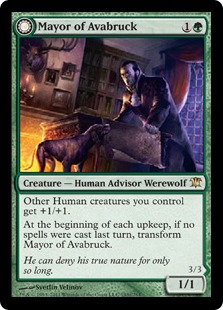 Mayor of Avabruck and Hamlet Captain
Mayor of Avabruck and Hamlet Captain
When most players hear "tribal", they think of lords like Goblin King and Lord of Atlantis. Mayor and Captain fill those role in Humans, putting you into a much more aggressive role. One big danger with this approach is becoming a worse version of Merfolk: it doesn't get much better than the redundant blue lords. You can overcome this by leaning on Thalia and Mage, effects Merfolk doesn't have access to, using your lords to exert pressure while opponents play around your static abilities.
- Magus of the Moon
I've always been interested in the "8Moon" space available to Modern players in Blood Moon and its Magus. Humans might be a great shell to take advantage of this, especially in a red-white or Jeskai-colored build that includes Champion, Thalia, and Mage. This presents your opponents with multiple pressures they need to overcome before they can win, all while being beaten down with creatures like Mantis Rider and Mirran Crusader. This seems like the least viable of the Human options, but it's an interesting one for metagames with many Moon-vulnerable decks.
If we are going to play interactive pieces like Lyev Skyknight and Aether Adept, then we also need a way to get them into the action at instant speed. This pushes us towards either Company or Vial. Personally, I'm leaning towards Vial because it's better with Thalia and is more discriminate than the random Company flips: when I need to bounce Deceiver Exarch, I can't hope for an answer in the top six cards. Running Vial makes us vulnerable to some nasty two-for-ones from Kolaghan's Command, but we have a few ways to handle that including Thalia herself. Once we are running Vial, we want to run cards that work well with the artifact. Borrowing from our D&T playbook, Blade Splicer jumps out, as does Noble Hierarch from the green-white version (see the recent 14th place SCG Chicago list for an example). Flickerwisp isn't a Human, but the Elemental is strong enough to include on its own merits and for its synergy with the rest of the deck. That leaves us with something like this:
Vial Humans, by Sheridan Lardner
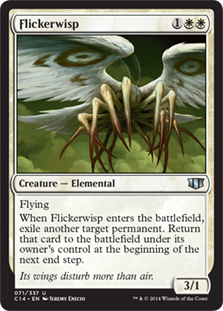 Vial Humans goes down to three colors from the original list's five, tightening the deck around a Bant core. Because Champion is the only Human that really cares about other Humans, we can safely use both Flickerwisp and Restoration Angel. These cards synergize with Splicer and Eternal Witness, not to mention retriggering Champion when targeting a Human. I also like the idea of flickering Mages depending on what cards you need to turn off. Flickerwisp and Skyknight combine with Vial to give us instant-speed interaction, with additional support from Path to Exile and Dromoka's Command. A bunch of Humans and powerful white hosers round out the board. I ran a few games with this against Grixis Control, Grixis/UR Twin, and Jund, all with fairly favorable results. Thalia and Mage are strong in these matchups, as is the combination of exalted with our flyers and first strikers.
Vial Humans goes down to three colors from the original list's five, tightening the deck around a Bant core. Because Champion is the only Human that really cares about other Humans, we can safely use both Flickerwisp and Restoration Angel. These cards synergize with Splicer and Eternal Witness, not to mention retriggering Champion when targeting a Human. I also like the idea of flickering Mages depending on what cards you need to turn off. Flickerwisp and Skyknight combine with Vial to give us instant-speed interaction, with additional support from Path to Exile and Dromoka's Command. A bunch of Humans and powerful white hosers round out the board. I ran a few games with this against Grixis Control, Grixis/UR Twin, and Jund, all with fairly favorable results. Thalia and Mage are strong in these matchups, as is the combination of exalted with our flyers and first strikers.
Conclusion
Hopefully this in-depth analysis gave you some ideas about building Humans in Modern and about deck development in general. The final Vial Humans list is a far cry from the original 5C Humans build, but sometimes you have to jettison old concepts to make something better.
What do you you think about the "Deck of the Week" article and approach? Anything you would like to see more or less of in future articles? Until the next time, keep the great Modern ideas coming and don't be afraid to step outside of the deckbuilding box!





I think that the final decklist is basically just a worse D&T deck. If you’re building Humans you should probably build Humans and lean harder on synergy, because otherwise you’re playing suboptimal cards for no real reason.
Perhaps, but this criticism is easily expanded to almost any version of Humans we do. A Lord-heavy version is a worse Merfolk, a Company build is a worse Elves, etc. We don’t want to force the Human theme too much if other decks are already doing it better. The idea in the last list is to pick things that Humans are uniquely good at and expand from there.
In hindsight, I wish I had tested Phantasmal Image in that last list, both for its general utility and for its synergy with Champion (-2 Angel, +2 Image). I’d also up the Cavern count in a control-heavy metagame.
I also like the idea of Mardu Human lists with Magus, Thalia, Aristocrat, Champion, and cards like Xathrid Necromancer. That’s another way to make the deck more Human-oriented.
Yeah, that does seem better. I think in Modern in particular since there are so many viable decks you really have to take a look and make sure what you’re doing is either new, or you’re doing it better/in a way that is better vs. the metagame than the other decks that are doing it.
The payoff for humans is just too low. The only actual tribal cards you’re running in that bant list are champion of the parish and cavern of souls. Every other card in the deck doesn’t care what type your creatures are.
Is champion of the parish good enough to bother limiting your choices? Would you play anything different in this list if you weren’t trying to leverage champion/cavern (but mostly champion)?
My experience in general with champion is that it asks you to overcommit to the board to become strong which is often exactly what you don’t want to do. You want to force them to wrath without overcommitting (in matchups where the wrath might be there). Norin decks solve this by buffing champion with norin flickers, but in any other deck you need 2 more bodies to get a wild nacatl – but then if you topdeck a champion it is absolutely not a wild nacatl
IMO you need more reasons to be forcing humans than cotp and cavern. I don’t think aristocrat even counts since its actually better to just go lingering souls into aristocrat than to play a bunch of humans :S
“Affinity is the king of micro-synergies”
Affinity is a macro-synergy deck of the highest order.
Almost none of Affinities cards are good on their own, compared to the cards you mention like Thalia and Meddling Mage.
Cranial Plating, Steel Overseer and Arbound Ravager are build around cards
I think this is just a difference of terms. Macro-synergies, as I view them, are card pairings that have big effects and require other cards to work at all. Exarch/Twin is the archetypical macro-synergy. Through the Breach and Griselbrand/Wurm is another example. So are Tron lands. In all these cases, you have pieces of a synergy that really need the other pieces to be effective.
In Affinity, you just have a giant pile of micro-synergies. Ravager eats other artifacts and sticks counters on Inkmoth, which is also an artifact. Plating makes things big, but not because you choose to play 1-2 cards: it makes things big because you are playing an aggressive artifact deck. Same with Overseer, who doesn’t require any one or two creatures to work. It just sticks counters on everything in your deck. These are build-around cards in the loosest sense, because the build-around for them is so simple and redundant.
Isn’t Kytheon, Hero of Akros a very viable option in this list? It is a human and it should be very easy to flip him, which in turn gives you the option to drop a new one.
Not sure what you could cut to make place for it but my first thought would maybe be cut 1 experiment and 1 cotp to make room for 2 kytheon.
Would love to know what you guys think of this.
Dude, I never knew my list made it to an article! Nice!
I think I was just testing the knight of new alara, and it won some games by just pushing damage after a turn 3 anafenza or mantis rider.